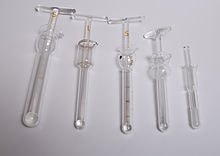Dounce homogenizer: Difference between revisions
Moving description of Dounce homogenizers from Alexander Dounce page to this new page |
(No difference)
|
Revision as of 01:55, 8 January 2019

Invented by Alexander Dounce, a Dounce homogenizer or "Douncer", is a cylindrical glass tube, closed at one end, with two glass pestles of carefully specified outer diameters, intended for the gentle homogenization of eukaryotic cells (e.g. mammalian cells). Dounce homogenizers are still commonly used today to isolate cellular organelles.
The two Dounce homogenizer pestles (known as the "loose" or "A" and "tight" or "B" pestles), have a carefully specified outer diameter, relative to the inner diameter of the cylinder. The "A" (loose) pestle has a clearance from the cylinder wall of (~0.0025 - 0.0055 in.) while the small pestle has a clearande of (~0.0005 - 0.0025 in.).[1] This allows for tissue and cells to be lysed by shear stress with minimal (if any) degree of heating, thereby leaving extracted organelles or heat-sensitive enzyme complexes largely intact.
Typically, a soft tissue (e.g. mammalian liver) is cut or broken into smaller pieces and placed into the glass cylinder, alongside a suitable volume of lysis buffer. Homogenization is performed by a defined number of "passes" of the pestles, first with the loose pestle, then with the tight pestle, up and down the cylinder.[2] 5-10 passes are typical. The Dounce homogenizers are typically produced from borosilicate glass, but are still fragile, and should be used with care. Especially hard or tough tissues should be pre-homogenized before use in a dounce homogenizer.
- ^ http://www.kimble-chase.com/literature/TissueGrinders.pdf
- ^ Dennison, C. (2013). A Guide to Protein Isolation. Focus on Structural Biology. Springer Netherlands. p. 42. ISBN 978-94-017-0269-0. Retrieved 2019-01-08.
